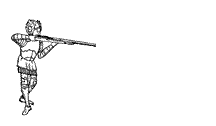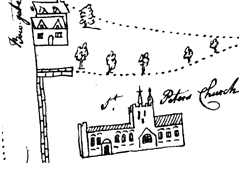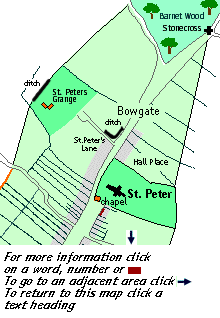Stone
Cross
The modern street name Stonecross derives from a
medieval roadside crosss and this was one of
several, probably normally of wood, in and around
the town. It was in existence by 1327 when it was
recorded as a point on the borough boundary, and
although shown on a map of 1634 (perhaps
symbolically) its site was described the following
year as "the site where the Stone Cross
was".
|
|
|
|
Known today as Bernards Heath. the name
seems to derive from a wood cleared by
burning. In1276 the wood was described as
next to the church of St. Peter perhaps
suggesting that at one time it stretched
further to the south. The wood was divided
into two parts namely Frithwood and
Communeswode. In 1440 bricks of St. Albans
bought at Le Frithe near St. Albans were
used in the ovens and fireplaces at the
royal palace at Kings Langley, Herts and
at the Tower of London. It was here that
the main body of the Dule of Warwick's
Yorkist forces engaged the Lancastrian
army of Queen Margaret in 1461 in what
became known as The Second Battle of St.
Albans. Queen Margaret was victorious and
sacked the town which really had no part
in the affair.
|

The second Battle of St. Albans was the
first in the country in which handguns
were used. Warwick's forces included a
mercenary detatchment of Flemish handgun
men
click
for a plan of the battle
|
The Northern end of St. Peter's Street was
known as Bowgate, perhaps derived from Borough
Gate. The short lived Charter of Freedom, gained
during the Peasants Revolt in 1381 granted "a
common of pasture from the town of St. Albans on
the high road as far as Stone Crouche"
(Stone Cross), which suggests that this
northern part of the town was not built up at that
date.In the later 15th century several crofts are
recorded here. In 1493 Isabella Lewis left 3s.
(15p) for the repair ofthe road in Bowgate.
St. Peters Lane led to St. Peters Grange which
the townsmen threatened to burn in 1381. Perhaps
because of this when John Moot was Abbot
(1396-1401), he built an "incomparable grange" with
cowshed, stable dovecot, kitchen and bake house and
surrounded it with a strong "earth wall" and deep
ditch.
|
|
|
|
Immediately to the north of St. Peters
churchyard was once a medieval house known
as Hall Place. Unfortunately this was
demolished in 1907 but photographs suggest
that it had an open hall with a three bay
crown-post roof and a cross wings. The
house was once the property of Sir Edmund
Westby and local tradition has it that
King Henry VI stayed the night there
before the First Battle of St. Albans in
1455 The name survives in Hall Place
Gardens.
|

|
|
|
Hall Place - to the north of the
churchyard,as mapped in 1634
|
|


